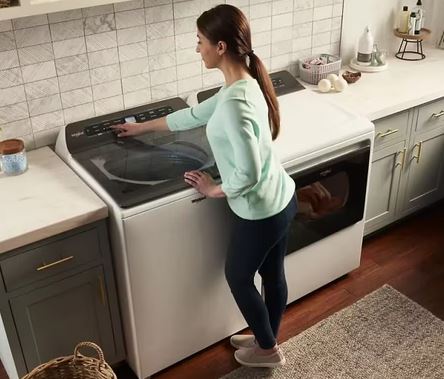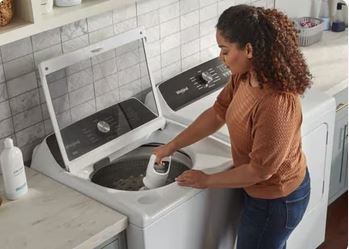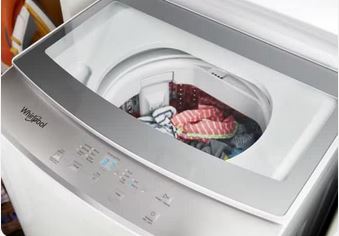Ordinarily, you expect a washing machine to start agitating and washing as soon as it fills up with water. But what if your Whirlpool washer fills with water then stops? What could explain such an anomaly?
Your Whirlpool washer may start filling up with water and suddenly stop due to an opened lid, wrong wash cycle, tub obstruction, drainage fault, burnt heater, or failed components such as the pressure switch, belt, motor, or control module.
Overall, you can at least fix the first five issues. That means you can only leave out a possibly failed component to an expert as they have the experience to run a more conclusive diagnosis.
This simple troubleshooting guide will enable you to identify why your Whirlpool washer doesn’t start running after filling up or stops filling up unexpectedly. And better, you’ll discover how to troubleshoot most of those reasons.
Moreover, we’ll look at other issues related to the washer’s filling process and how you can address them, too, DIY. Let’s dive in!

In a hurry? Below are the six issues behind a Whirlpool washer that fills up and stops and their quick fixes.
Whirlpool Washer Fills with Water Then Stops – Quick Fixes
| – | Likely Cause | Quick Fix |
| 1. | Opened Lid | Clear any lid obstruction and replace the lid switch if it fails the multimeter continuity test. |
| 2. | Wrong Wash Cycle | Cancel any unintended soaking-related cycle such as Bulky Items, Heavy Duty, Delicates, or Towels. |
| 3. | Tub Obstruction | Remove visible obstructions on the washer tub. |
| 4. | Drainage Fault | Unclog the drain hose and pump and replace the water inlet valve if it fails the multimeter continuity test. |
| 5. | Burnt Heater | Replace the heating element if it fails the multimeter continuity test. |
| 6. | Failed Component | Take your washer for servicing and replace a defective or worn-out pressure switch, belt, motor, or control module. |
Why Does My Whirlpool Washer Fill with Water Then Stop?
As I mentioned, a Whirlpool washer should start agitating or washing, depending on the type, as soon as it completes the water fill-up process. If yours doesn’t do that, it’s most likely due to one of these six issues:
1. Opened Lid
Whirlpool washers mostly don’t have a problem filling up water while the lid is open. They, however, won’t run if the lid stays up. And remember, it’s the door for a front loader.
Overall, the lid or door could be open due to a failure to latch it or an obstruction. And if it’s neither of those, it’s most likely a defective lid switch.
Overall, you can tell if the lid switch is to blame if the washer turns on, fills up, stops, and makes no noise.
Fix
Try to see if something obstructs the lid and remove it before firmly latching it. If there’s none and the lid won’t lock, use a multimeter to check if the lid switch displays electrical continuity and replace it if it doesn’t.
2. Wrong Wash Cycle
Just because your Whirlpool washer stops after filling with water doesn’t mean that something has to have failed. Sometimes, it’s a case of selecting the wrong cycle.
For example, you can expect your Whirlpool washer not to move to the next cycle immediately if you’ve selected a soaking-promoting cycle. That includes options like Bulky Items, Heavy Duty, Delicates, and Towels, which force the washer to draw in more water to soak up the laundry before moving to the wash phase.
Fix
Check if you’ve unintentionally selected a soaking-related wash cycle and cancel it before picking another. If the selection is intentional, all you’ve to do is wait.
3. Tub Obstruction
If something obstructs the tub, especially the drum lock, the washer will stop once it fills with water. It just won’t move to the agitation phase or clean the laundry.
Fix
Inspect the tub for any visible foreign materials and remove them.

4. Drainage Fault
The fill-up and the drainage processes work hand in hand. If the washer doesn’t drain properly, it will stop filling up and won’t agitate. So, this could be why your Whirlpool washing machine is behaving that way, and if so, it could be due to:
- Drain hose obstruction – Clogs or kinks could obstruct the drain hose. In either case, the washer will struggle to drain.
- Pump obstruction – You also have to inspect the drain pump for dirt clogging, as that could obstruct it just as much as it does the drain hose.
- Water inlet valve malfunction – Your Whirlpool washer will struggle to drain if the water inlet valve fails.
Fix
Clear any kinks or clogging from the drain hose, and clean the drain pump thoroughly if it’s filthy. Also, inspect the water inlet valve for dirt obstruction and clean it. However, if the inlet valve is not dirty, examine it with a multimeter and replace it if it fails the continuity test.
5. Burnt Heater
Usually, the washer automatically turns on the heating element when it starts filling up with water. In that case, the washer stops filling up once it detects that the heating element is defective (or burnt), something you can check visually or using a multimeter.
Fix
Observe the heating element for signs of burns and replace it. If you can’t find any, check its terminals with a multimeter and replace it if it fails to display electrical continuity.
6. Failed Component
Lastly, if the reason your Whirlpool washer stops filling isn’t any of the above, it’s most likely a failed component. If so, check the following:
- Pressure switch (or water-level switch) – The pressure switch monitors the washer’s water level. That explains why it’s also known as the water level switch. If this switch fails, the washer will stop filling up abruptly.
- Washer belt – If the washing machine’s drive belt is defective, the drum won’t turn, which means the washer will stop once it fills up with water.
- Drive motor – The drum will also fail to turn if the drive motor is defective, and in most cases, the motor makes some noise.
- Control module – Tasked with controlling all washer functions, you can expect your Whirlpool washer not to run if the control module is short-circuited.
Fix
Overall, it’s never easy to determine if the above components are faulty. So, you may need a washer expert’s help here. Sometimes, all the expert has to do is service the washer. So, give them a chance to have a look at it.
Whirlpool Washer Stopped Working Full of Water
If your Whirlpool washer stops working, but it’s full of water, it’s most likely a drainage problem, and if so, the issue could be an obstructed drain hose, drain pump fault, or wrong drain hose height (perhaps less than 39 inches).
If the issue is not a drainage fault, it could be a wrong cycle, a large wash load, an open lid, or excess suds. So, you can start with these checks before checking for a drainage fault.
And lastly, it could also be a timer malfunction or a defective lid lock or switch. In all cases, a replacement may be necessary.

Whirlpool Washer Won’t Stop Filling with Water
Now imagine your Whirlpool washer continually filling up and not stopping. Of course, that points to a malfunction, and it could be due to the following:
- Power failure
- Leaky hoses
- Pump failure
- Inadequate water pressure
- Opened lid or door
- Defective water-level switch
- Obstructed or faulty water inlet valve
- Burnt control board
Whirlpool Washer Fills with Water but Won’t Wash
If your Whirlpool washer fills up with water but fails to start, the issue could be inadequate power, power spike, or power disruption. It could be an unbalanced load, a paused wash cycle, or an error code if it has nothing to do with the power supply.
But if none of those issues, it’s most likely a defective component such as the lid switch, timer, cycle selector, drive motor, pressure switch, or drive belt.
People Also Ask
1. Why Does My Washer Stop After It Fills with Water?
Your washer stops after it fills with water because of an unlatched lid or door, a wrong wash cycle, or an obstructed drum. If that’s not the case, it could be a drainage problem, a burnt heating element, or a defective motor, drive belt, pressure switch, or control module.
2. Why Does My Whirlpool Washer Keep Filling with Water?
While it’s abnormal for your Whirlpool washer to continue filling with water, there’s an explanation. For one, it could be a power failure, a leaky inlet hose, an unlatched lid, or a damaged water-level switch.
If that’s not it, it could be a defective water inlet valve, a malfunctioning drain pump, or a burnt control board. You can ask for a washer expert’s help to inspect these components for fault and perhaps replace them on your behalf.
3. What to Do When Washer Fills with Water Then Stops?
You can do several things when your washer fills with water and stops. Your action, however, depends on the reason behind the problem. Here are some critical steps:
- Closely latch the lid and remove anything that could be obstructing it
- Test the lid switch’s continuity if the lid won’t shut and replace it
- Cancel any wrong setting, especially one that promotes prolonged soaking
- Remove any obstruction from the tub
- Fix any drainage issue
- Replace a burnt heating element
- Replace a defective drive motor, washer belt, pressure switch, or control module
4. Why is My Whirlpool Washer Stopped with Water in It?
Your Whirlpool washer has stopped with water in it because of an issue with its drainage. It could be that the drain hose, washer filter, or drain pump is excessively clogged. It could also be that the drain hose height is wrong, or there are many kinks along the drain hose. And lastly, the drain pump might be defective, thus unable to pump out the excess water.
Concluding Thought:
Now you know what six issues to check when your Whirlpool washer fills with water then stops. Start with the lid to ensure it’s not up, then move the wash cycle to confirm you’ve selected the correct one.
The next stop is the tub, which you should check for obstruction and then move to the drainage system to check and fix any drainage faults.
Once you rule all those issues out, check for a burnt heating element or a defective pressure switch, belt, motor, or control module and replace it (with a washer expert’s help).
Also Read:
